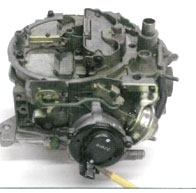
Any carburetor originally equipped with a hot-air-style choke can be converted to an electric choke in minutes. The vacuum supply to the housing must be blocked off and the gasket under the choke discarded because the unit uses the housing as a ground.
The Quadrajet saw expanded use onto a wide variety of 1966 Chevrolet V-8 and Buick 400 and 425 V-8 cubic-inch engines in 1966. Oldsmobile followed suit. By 1967 Cadillac and Pontiac too had begun installing the Quadrajet on most of their 4-barrel applications. With its growing popularity and efficient design, the Quadrajet was the most widely used production 4-barrel carburetor on GM-produced engines during that time. And though other carburetors such as the Rochester 4G, the Carter AFB, and the Holley 4-barrel were used on certain engines, the Quadrajet quickly became a benchmark for other 4-barrel carburetor manufacturers.
The 1968 model year marked the first nationwide federal standards for specific pollutants. And because of its efficiency and excellent balance of economy and performance, the 4M Quadrajet became the standard production 4-barrel carburetor for all GM manufacturers. The Rochester 4Gwas phased out as the Quadrajet replaced everything except the Holley 4-barrel, which continued on certain Chevrolet applications through 1972.
All that’s needed for proper choke operation is a 12-volt power source that is activated when the ignition key is in the “ON” position.
A good power source location is at the windshield wiper motor. It is usually mounted on the firewall behind the engine and has a wire that is activated when the key is switched to the “ON” or “RUN” position.
